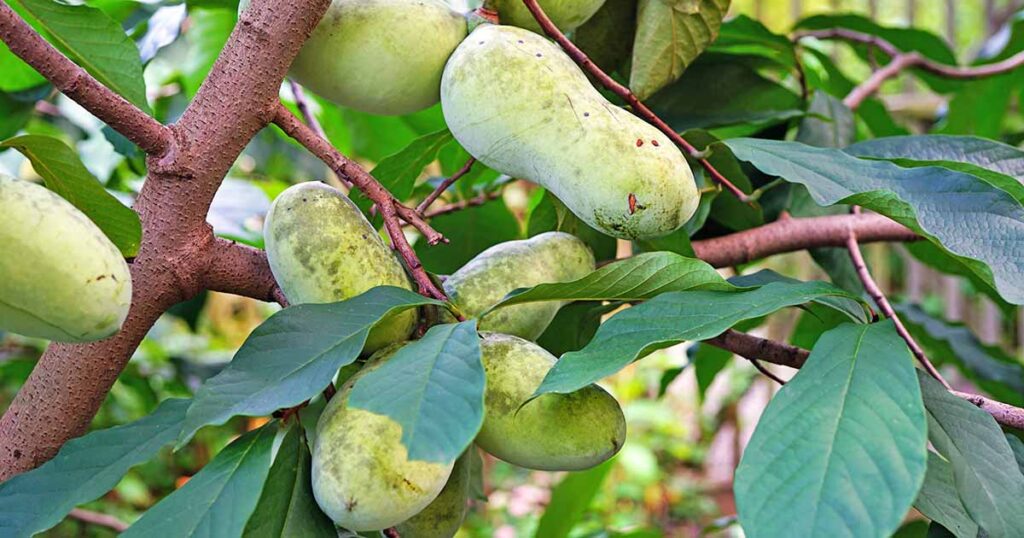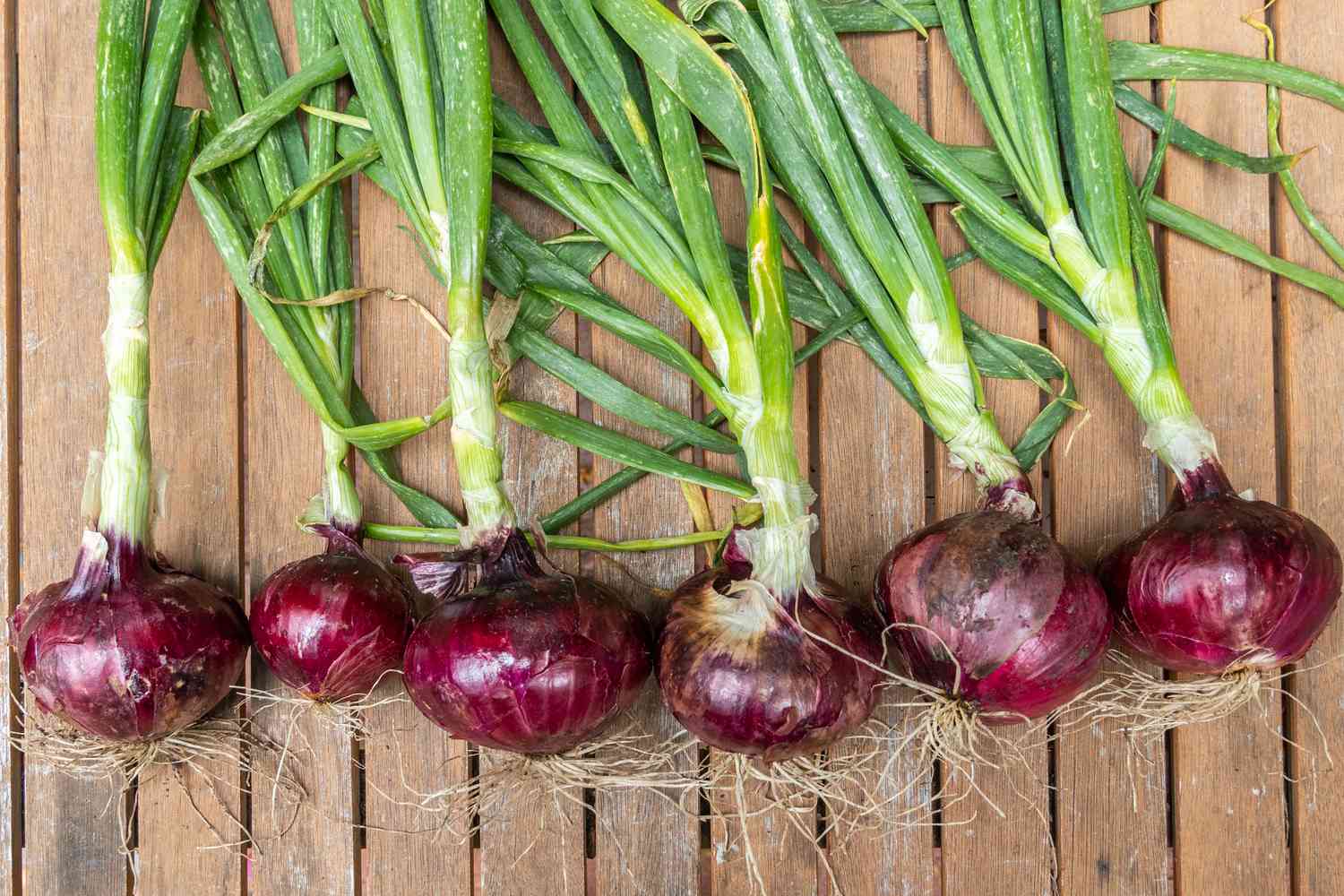
Pawpaw, paw-paw, or paw paw? It doesn’t much matter how you spell it—it’s an easy tree to grow and a tasty fruit to eat. Pawpaws are the largest edible fruit trees native to North America, specifically in the temperate climes of the eastern parts of the United States, though you won’t often find them near the coasts. Pawpaw, paw-paw, and paw paw are all accepted spellings, while the scientifically minded among us know the pawpaw tree as Asimina triloba, a species in the plant family Annonaceae.
The pawpaw tree is a favorite of gardeners across the Southeast because of its dark green foliage, tropical appearance, and abundant fruit—also called pawpaws. Pawpaws are fragrant and have a distinctly bright, tropical flavor and custard-like texture. If you encounter freshly ripe pawpaws, go ahead and dig in. One bite, and you’ll be enjoying one of America’s best-kept-secret fruits. (Just be sure to avoid the skin and spit out any seeds, which are mildly toxic to humans. Leaves and stems are toxic to people as well.1) You’ll know they’re ripe when the fruits are close to falling off the tree and the flesh is soft with a slight give. The pawpaws’ short shelf life means you should take them when you can get them, though they will last a little longer when refrigerated. Eat them out of your hand, or puree them and add them to a smoothie, ice cream, or pie.
The trees’ tropical characteristics makes it seem like they would be happier closer to the equator, but pawpaw trees thrive in the South’s temperate climates and deciduous forests. Pawpaw trees can grow about 30 feet tall, with nearly 3-foot-long oval-shaped fruits that start yellowish-green and ripen to brown. They can be a source of seasonal color because the leaves turn bright yellow in autumn (think fall ginkgo hues), and then their brown, velvety flower buds open to deep burgundy flowers from March to May. Plant this tree in early spring or later in fall when it isn’t actively growing, then care for this easy tree according to our guide below.
Pawpaw Care
Pawpaw trees are versatile in the landscape, growing in deep shade to full sun from Canada down to Florida and as far west as the borders of Nebraska, Oklahoma, and Texas. Young trees need more protection from the sun. As pawpaws naturally grow in rich, moist forests, they do well near streams and lakes, in woodland gardens, or anywhere there is well-drained and fertile soil.
Plant trees at least 10 feet from your patio or sewer lines, and include a second variety of pawpaw somewhere on your property if you want to be sure of pollination. Pawpaws are pollinated by beetles and flies, but also attract the zebra swallowtail butterfly, whose caterpillars feed on the foliage. These trees don’t transplant well because of the delicate taproot, so buy pawpaws from a grower rather than trying to transplant one from the wild.
Light
Pawpaw trees can grow in deep shade but won’t produce as much fruit. Young and growing pawpaw trees prosper in partial shade, as too much direct sunlight can scorch their leaves and cause fruit production to slow or even stop. If you plant the tree in full sun, protect young saplings with a shade cloth or find another way to block hot afternoon sun until it matures. Once the tree has matured, full sun (about six to eight hours of sun exposure a day) will result in the most fruit. Interestingly enough, depending on what type of light the tree is exposed to its shape will change. Trees that grow in direct sun have a more pyramidical shape, whereas those in more shady areas spread out, or have a more round shape, and not grow as many lower limbs.
Soil
The soil around the pawpaw should be slightly acidic (pH balance of 5.5- to 7), well-draining, and fertile for best growth and fruit production.2 Don’t plant a pawpaw in heavy clay. Adding compost to the soil can help with the soil’s quality and overall health.
Water
Younger pawpaw trees require frequent watering during the first year so they can get established. Just make sure not to overwater your tree, as this can cause issues. Make sure the soil surrounding the base remains moist. Mature trees that have access to regular rainwater, or are growing near a water source, shouldn’t require much additional watering. Pawpaws can withstand occasional wet soil but shouldn’t be planted in an area frequently inundated with water. If planted in an orchard or drier soil, occasional watering can be helpful. Trees should receive about an inch of water per week between rainfall and watering.
Temperature And Humidity
The pawpaw tree is hardy to USDA Plant Hardiness Zone 5 and can handle cold temperatures up to -20 degrees Fahrenheit.3 The tree does best in a climate with hot and humid summers. Pawpaws may drop fruit prematurely during a dry heatwave.
Fertilizer
We recommend fertilizing your pawpaw trees biannually with a well-balanced fertilizer or adding compost or organic matter to your soil. Wait to fertilize until the second year, as young trees can be sensitive. Use a balanced fertilizer in early spring and again in early summer, and spread under the entire tree canopy according to package directions.
Types Of Pawpaw Trees
Though pawpaws aren’t the most common tree for home gardens, many specialty garden centers and native plant nurseries do sell them. When ordering your pawpaws, be sure to plant two or more selections to ensure cross-pollination. If you place an order online, note that pawpaw means “papaya” in other parts of the world, so make sure you’re getting the right tree—if not, you may be cooking with papayas instead of pawpaws come harvest time. Here are a few selections to choose from:
- ‘Pennsylvania Golden’: This variety produces abundant and very sweet fruit.
- ‘Potomac’: A very upright tree with large, yellow-fleshed fruit.
- ‘Shenandoah’: This high-yielding tree has mild and succulent fruit.
- ‘Susquehanna’: This variety has very sweet fruit with a strong flavor.
- ‘Wabash’: This productive tree has fruits with mango-colored flesh.
- ‘Wells’: The yellow-orange fruit of ‘Wells’ has a banana-like flavor.
Pruning
Pawpaws don’t require much pruning, but you should remove suckers from the base if you want to train it as a single-stem tree. Otherwise, remove crossing, damaged, or diseased branches. The best time to do so is in winter. The trees produce fruit on new growth, so a bit of pruning each year may help with fruit production on older trees.
Propagating Pawpaws
Pawpaws are best propagated from seed by home gardeners. Propagating from cuttings is considered difficult and has a low success rate.
How To Grow Pawpaws From Seed
Pawpaw seedlings can be grown from seed, but must be stratified—that is, subjected to cold temperatures—before they will germinate. Follow these steps to grow pawpaw seeds:
- Collect a ripe fruit, remove the seeds from the pulp, and rinse them in water. Do not allow the seeds to dry out.
- Place the seeds in a sealable plastic bag with moist sphagnum moss. Store them somewhere cold, like your refrigerator or in a sheltered spot outdoors, for at least 60 days and up to 120. Seeds germinate well when they are exposed to 35° to 45° F.
- Plant the seeds 3/4 inch to 1 inch deep in a container filled with well-draining potting soil. Keep the soil damp and place the pot in a warm spot to aid in germination.
If you prefer to let nature take its course, seeds can also be planted directly in the garden in fall. Be sure to mark where you planted them, as seedlings may not appear well into summer.
Overwintering
Pawpaws are cold-hardy and don’t require extra protection for winter in the South.
Common Pests & Plant Diseases
These trees are pest-resistant but are not bulletproof. Zebra swallowtail caterpillars usually don’t cause significant damage to the foliage. The larvae of a small moth called the pawpaw peduncle borer can destroy many of the tree’s flowers. Raccoons and squirrels may eat the fruit.
Trees can develop powdery mildew or black spot in moist areas. Spraying with a copper-based fungicide can help control serious problems.
How To Get Pawpaws To Bloom
Pawpaws produce deep maroon or purple flowers on last year’s growth in mid-spring. The flowers have an unpleasant scent that attracts beetles and flies rather than bees. Trees will produce more flowers and thus more fruit in a sunnier spot.
Common Problems With Pawpaws
This easy tree requires little attention as long as its planted in a suitable spot. Here are a couple of common problems with pawpaws:
Tearing Leaves
Some protection from the wind can be helpful for pawpaw trees, which have very large leaves that can tear.
Poor Fruit Production
Pawpaws can’t self-pollinate since the male and female flower parts mature at different times. You’ll need a genetically dissimilar tree nearby to aid in pollination. If that doesn’t do the job, dedicated gardeners can hand-pollinate by using an artists’ brush and collecting pollen from the brown male anthers of one tree, then brushing it onto the shiny green pistils of the female flowers.


